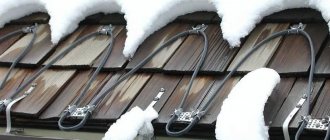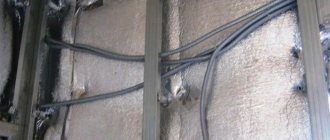How to properly install wiring in the kitchen?
The electrical wiring diagram in the kitchen has many differences from the wiring diagram in the living room. After all, here, in addition to such unfavorable factors as water, there are a large number of household electrical appliances. The room itself is often small, and the convenience of the entire room depends on how compactly and correctly we can lay out the wiring.
Kitchen electrical planning
The kitchen electrical network can be roughly divided into a lighting network and a socket network. The reliability, efficiency and comfort of the premises depend on how correctly we plan them. So let's look at each of these networks separately.
Kitchen lighting network
Let's start with the lighting network. It must necessarily contain general lighting and local lighting of the work area. In addition, zonal and decorative lighting is often used.
General lighting in the kitchen should be at least 150 lux. It can be top, side or combined. Top lighting is when lighting falls from above, side lighting from the side, and a combined type of lighting when lighting falls from above and from the side.
So:
- Combined lighting is considered ideal . But here everything depends on natural light. If you have a large enough window in the kitchen that provides enough light during the day, then you can get by with only overhead lighting. If there is not enough natural light, then you can use overhead lighting with several lamps installed in different parts of the room. This already depends on the layout.
General lighting in the kitchen
- Side lighting is used mainly in rooms with low ceilings. After all, even in small rooms it requires the installation of at least two lamps. This type of lighting is characterized by the presence of a large number of shadows. They can be reduced only by installing more lamps.
- The second mandatory component for the kitchen is special lighting for the work area . According to clause 2.12 of VSN 59 - 88, this lighting should be at least 200 lux, but our instructions advise making it at least 300 lux.
Kitchen Glow Factor
Lighting the kitchen work area can be done by installing additional lamps on the kitchen apron, directly installing lamps in the furniture above the work area, or newfangled luminous aprons.
Installation of work area lighting fixtures on the wall
The cheapest and easiest to implement is to install lamps on the kitchen apron. Typically, several fluorescent lamps are used for this.
Embedding work area lighting fixtures into furniture
- Embedding spotlights into furniture will require you to create a 12V network . If you build 220V lamps into furniture, you will need additional protection from possible electric shock, which will waste space in the furniture itself.
- In some larger kitchens, you can additionally create zone lighting . Usually it is used to highlight the dining area. For this purpose, spotlights from the upper or lower light, directional lamps on the walls and a variety of decorative lamps can be used.
Zone lighting for the kitchen
If you have elements in the kitchen that need to be illuminated or you just want to diversify the room with bright colors, then you can use decorative lighting. But let us immediately note that this should only be done in large rooms. In cramped kitchenettes it will not be possible to achieve a significant effect.
Kitchen socket network
If we do the electrical wiring in the kitchen ourselves, then the next important aspect is the location of the sockets in the kitchen. Since there are quite a lot of them required in the kitchen, deciding on their place is far from easy.
So:
- According to clause 12.27 of VSN 59 - 88, in the kitchen of the apartment there must be at least 4 sockets, one of which must be for a current of 10 or 16A. In addition, if an electric stove is installed in the kitchen, then there must be another outlet with a current of at least 25A and powered from a separate group line.
- But these are the minimum standards. A modern kitchen requires a significantly larger number of outlets. In order to plan their number and location, you need to know the number of household appliances and their location.
- If we have an electric stove, then the socket for it is usually installed behind the stove at the bottom - 20 - 30 cm from the floor (see How to install a socket for an electric stove with your own hands). The same applies to the sockets of the refrigerator, oven, dishwasher, freezer, washing machine and other large electrical equipment installed on the floor.
- In addition to large stationary equipment installed on the floor, we may have stationary equipment installed on the second tier of the kitchen. This includes a microwave oven, TV, electric ignition of a gas stove and much more. For this equipment, sockets are installed behind these devices at a level of 1 - 1.5 meters from the floor.
- For many who do their own electrical wiring, powering the hood and other electrical equipment installed on the third tier of the kitchen becomes a problem. For them, sockets are installed at a distance of 20 - 30 cm from the ceiling. This is usually the distance from the top of the kitchen to the ceiling.
- This may seem unusual to some, but there is nothing to worry about. The PUE norm allows this. If your kitchen set is supported by the ceiling, then such sockets can be placed behind the furniture.
- A separate issue is the placement of sockets for mobile electrical appliances. They are usually used in the kitchen work area. Therefore, to connect them, 2–3 sockets should be installed here. The number of sockets depends on the number of mobile electrical appliances.
- Questions often arise regarding the installation of these outlets. Indeed, now on the market, in addition to conventional sockets, a variety of corner, built-in and retractable models are quite widely represented. It's a matter of your liking. The main thing to pay attention to is that these sockets cannot be filled with water from the table, dirt from the table does not get into them, and they are tightly fixed with the plug. If the fixation is very tight, make sure that over time this will not lead to breakage of the fasteners.
- In addition, we will probably need at least one outlet in the dining area. It can be used to charge mobile or other temporary electrical appliances. As a result, it turns out that for the kitchen we will need at least 10 sockets, or even more.
EOM power distribution network project for office workplaces
Details Category: Electrical project.
EOM We developed design documentation for the electrical network, connecting workplaces in an office building .
Abbreviated name of the system: ERS. The ERS is designed to distribute electricity from uninterruptible and general power supply panels to cross-connect consumers, security system equipment, computer equipment and household consumers of automated workstations (AWS) of the designed building. The main purpose of creating an EDS is to provide an automated banking system, communications and telecommunications in the OJSC building, electricity of appropriate quality with acceptable reliability indicators (in accordance with GOST R 54149-2010). Requirements for the electrical power distribution system for the categorization of this group of consumers, the battery life of the system, are taken into account when developing the uninterruptible power distribution network of the building and are not considered in this section of the working documentation. The initial data for design are:
— Special technical conditions for the design of fire protection for the administrative and banking complex building;
— Technological specifications for office premises, IT premises, MMS, etc.;
— Architectural and technological layouts of the building.
When creating the EPC automated workplace, only technologies and hardware and software approved for use on the territory of the Russian Federation should be used.
Creating a Kitchen Electrical Network Diagram
So we have decided on the number of electrical points that we have to install in the kitchen. But wiring in the kitchen involves creating a circuit that will divide our electrical network into several groups. And here we cannot do without calculations.
- In order to form an electrical network, we need to divide the entire load into separate groups. Each group will be powered by a separate machine. Usually they use 16 or 25A machines.
- Load sharing can be done according to the type of load, that is, the lighting network from one machine, and the socket group from another. Or you can do a mixed one and the sockets and lighting are powered from one group. Each of these methods has its own arguments, which we will not present now. The choice is yours.
Kitchen power supply diagram
- Knowing the number of electrical points, we can sum up their rated current until we get a value close to, but less than, 16 or 25A. You can see the rated current in the device passport.
The photo shows a table of the approximate power of various electrical appliances
- If there is no such thing in the device’s passport, then it can be calculated using the formula. I is our rated current, P is the power of the device in kW, and U is the rated voltage, which for a single-phase network is 220V. In general, this is not a complete formula, but for our simplified calculation it is quite enough.
Note! When setting the load for each group, keep in mind that all devices are unlikely to work at the same time. And too much reinsurance will lead to an increase in the cost of your scheme.
- Since most likely the electrical wiring in the kitchen and the circuit will involve the presence of several groups, it is also worth taking into account the factor of the geographical location of the outlets. After all, you will agree that it will not be very convenient to pull a wire across the entire kitchen to power one outlet on the opposite wall.
- You should end up with one to three groups. This amount depends on the number of household electrical appliances.
Result
As a result, we obtain a correctly calculated demand coefficient for the shield and the correct calculated powers and currents in the group network.
Next, DDECAD users continue to fill out the calculation table, which automatically calculates short-circuit currents, voltage losses (drops), and RCD leakage currents. After pressing one button, a single-line diagram of the shield is automatically obtained in AutoCAD.
Subscribe and receive notifications of new articles by e-mail
Installing electrical wiring in the kitchen
Once we have decided on the location of the electrical points and the electrical network diagram, we can proceed directly to the installation. We will not reveal all the “secrets” of wall slitting and proper fastening of wires, but we will dwell on some aspects in more detail.
| Single-pole group circuit breaker 16A | Installation of any new lighting group begins with the installation of a group circuit breaker in the apartment panel. Since, according to the PUE standards, the neutral wire should not have switching devices along its entire length, the installation of a single-pole circuit breaker is a prerequisite. Its purpose is to protect your electrical wiring from short circuits and overloads. |
| If you have an electric stove, a three-phase network may be connected to your apartment panel. In this case, a separate group is organized to power the furnace, protected by a three-pole circuit breaker. If the electric oven is powered from a single-phase network, then you will need the same machine as shown in the figure above, only with a rating of 25A. |
| An RCD circuit breaker is a residual current device designed to protect a person from touch voltage. It responds to leakage current that appears when the insulation resistance of conductors decreases. In our case, the device should be selected for a leakage current of 30 mA. |
| To lay a single-phase network, use a three-core wire | Wiring should be done with a three-core wire. Moreover, the PUE requires compliance with the color marking of the wire. One core should be yellow-green in color and is intended for protective grounding. One core should be blue, and it is intended for connection to the neutral conductors. And the third core for a single-phase network can be of any other color and is intended for connection to phase conductors. |
| Transformer 220/12V | If your electrical network provides a 12V network, then you cannot do without an appropriate transformer. Modern transformers do not require maintenance and are almost silent. The main thing is to choose a product that matches the connected load. To do this, the total power of all connected lamps must be lower than the rated power of the transformer. To be sure, it is better to choose a product with a margin of 10–30%. |
- According to clause 7.1.71 of the PUE, it is recommended to provide an RCD for each group. Moreover, according to clause 7.1.76 of the PUE, it must be located after the group machine.
- As you know, wiring can be done in an open or hidden way. But for apartment kitchens it is recommended to use the same type of wiring as for residential premises. In our case, this is hidden wiring.
Wire size selection table
- The wire cross-section is selected according to the table. 2.1.1 PUE. But there are certain limitations here. According to clause 7.1.34 of the PUE, copper wiring must be used in residential premises. Moreover, its cross-section should be no less than 1.5 mm2.
Note! Until 2001, aluminum wiring was allowed in residential premises. Now this is prohibited.
- But if you select wiring for each connection, then this is quite troublesome and it is unlikely that the price for different types of wiring will differ significantly and will allow you to save significantly. We advise you to install a wire with a cross-section of 2.5 mm2, which is of course a little more expensive, but for sure. And during the installation process, you don’t have to worry about which wire goes to which outlet.
- No group can do without distribution boxes. If you have a mixed group, the box is usually mounted above the light switch. If there are several lighting switches in a group, they are usually mounted above the one closest to the exit.
- If you have a purely socket group, then the distribution box should be located in a convenient and equidistant location from all powered electrical points. They should not be placed behind cabinets or other furniture that would block access to the box.
- If you have a 12V network, then you should install a transformer. The optimal place for this may be a distribution board. But if it is far away, then you can try to hide it in a junction box. You just need to choose the appropriate box size.
- I would also like to draw your attention to connecting the transformer. If you do not have special conditions, then it is better to install the switch for it at a voltage of 220V, and not at 12V. This will reduce the likelihood of damage and also reduce energy consumption. After all, even at idle, it consumes at least a little electricity. And in annual terms these can be significant numbers.
- Otherwise, the kitchen electrical network and installation are exactly the same as for living rooms. You can easily do it yourself, as demonstrated in the video.
How to groove the ceiling and walls in concrete and brick walls for hidden electrical wiring
Grooving is the making of grooves in the walls and ceiling for laying electrical cables, as well as hollowing out niches for electrical panels and socket boxes. The grooves can go any way, but it is more professional and practical to make the grooves at right angles. This is done in order to subsequently understand how hidden wires and cables pass and not accidentally damage them by drilling through them. For gating, you need a hammer drill with a power of 800 W or more and a powerful grinder with a diamond blade or a wall chaser.
Pre-marked grooves are cut with a diamond disc; the size of the grooves is made according to the number of cables being laid. The cuts are made along the line of cable routing and short cuts across. We hollow out everything that is not needed with a hammer drill, with attachments in the form of a peak or spatula.
Types of design: standard and individual
There are two general approaches to electrical wiring design:
- typical;
- and individual.
Typical electrical projects are focused on the standard configuration of apartments and buildings and, as a rule, involve the implementation of only basic electricity distribution schemes.
However, it is worth noting that “standard” does not mean “simplified” at all - among the proposals of design organizations one can find very complex standard solutions. The correct interpretation of this term rather means “fixed” - that is, it does not involve spending time on individual adaptation.
So, for the same apartment layout in a new building there may be several standard electrical projects, varying in level of complexity. But in any case, such a solution will be cheaper than individual development.
Individual design of power supply networks involves the development of an electrical project “from scratch,” focusing only on the architectural design of the building and the wishes of the customer. This is a longer process than typical electrical design, but is virtually unlimited in its capabilities.
However, despite the complexity and relatively high cost, individual design is used when developing original houses and cottages.
What does an electrical project consist of?
A standard power supply project consists of several sheets, these are:
1. Title page
2. The act of delimiting balance sheet ownership and operational responsibility
3. General data sheet and explanatory note
4. Single-line power supply diagram
5. Lighting network plan
6. Outlet network plan
7. Diagram of an additional potential equalization network
8. Equipment specification
All these sheets of the electrical project contain all the necessary information, both for the supervisory authorities approving this project, and for the electricians and electricians who will connect your facility (apartment, private house, etc.) to the electrical networks and carry out subsequent electrical wiring.
All pages of the power supply project must be designed in accordance with the Unified System Design Design Document.
ESKD is a unified system of design documentation. Which includes a set of state standards establishing uniform rules and regulations for the development, execution and circulation of design documentation in all areas of industry, construction and transport.
Stage two: Drawing up technical specifications and power supply design
A technical specification is a summary of what you need to get from the project.
Based on the results of the site inspection, we determine that:
- The apartment's power supply category is third;
- Number of panels – 1. This is an apartment electrical panel, located in the hallway;
- Electrical wiring is done hidden on the walls under a layer of plaster. Passages in the walls are made in PVC pipes with a seal;
- All installation locations of the switchboard, power sockets, lamps, sconces, switches are marked on the apartment layout diagram;
- For each room, a list of installed equipment is compiled indicating their capacity;
- Electrical equipment that requires separate power cables is highlighted separately.
The future project will include:
— Explanatory note; — Apartment electrical circuit diagrams; — Scheme of groups of socket networks; — Schemes of lighting groups; — Schemes of wiring (wiring) in distribution boxes; — List of apartment equipment and necessary materials (specification).
The task has been drawn up, and the design stages can begin.
Maximum difficulty level
Along with simple approval schemes for electrical projects, there are also those where the bulk of the time allocated for design is spent on approvals.
The most complex projects in this sense are projects of external electrical networks, the development of which may require dozens of different approvals.
Considering that external power networks are usually located on the territory of a city or town, before starting to develop a technical solution, designers need to determine the permissible route for placing the line.
In turn, in order to accurately determine the route, it is necessary to carry out a series of approvals with the owners of the land along which the line will pass, as well as with almost all municipal services:
- with Gorvodokanal;
- with Rostelecom;
- with the main architectural department of the city;
- with the city landscaping service;
- with the metro;
- with city utilities;
- and even with the traffic police, if the construction of the line involves the suspension of traffic on the road.
In some cases, a separate project application is submitted to the appropriate authority describing the features of the intersection of the power line and city communications.
Let us note that quite often an attempt to approve a project of this type is met with a categorical refusal, which leads to the need to change the power cable laying diagram and adjust the estimated cost of the project.
It is important to consider that when developing external electrical networks, approvals are an integral part of the detailed design. Coordinated external power supply project
Coordinated external power supply project
Also, as an example of an electrical project, the approval of which has the maximum level of complexity, we can cite the sequence of developing a power supply network for a multi-story building.
Considering that in addition to the internal network, modern housing cooperatives have an extensive external electrical network, it may take more than one month to receive a project approved in the prescribed manner.
Please note that when drawing up a regulatory act authorizing the construction of external power supply networks, simultaneously with electrical calculations for approval, you must provide:
- topographical explication of the territories where the power line is planned to be located (including indicating underground communications);
- work plan required to open a warrant for construction and installation work (the warrant is issued at the city architectural department);
- a list of measures to organize traffic restrictions (provided to the traffic police);
- certificate of authorization for installation work issued to the performing organization.
Electrical project development
It is better to order the development of an electrical supply project after creating a complete design project for your apartment or house. This is the most rational way, because a professional design project usually includes the arrangement of furniture and equipment. Using this information, you can position sockets, switches and lighting fixtures as accurately and correctly as possible, as well as distribute the loads between them.
Often professional design projects already include specifications of all necessary equipment, incl. and power. All this will help the designer make a high-quality electrical project that fully meets all the requirements.
If for some reason you do not plan to order a design project from a professional designer, you can compile all the necessary data yourself, we will talk about this in the following articles.
Of course, you most likely won’t be able to think through and calculate everything, make the scheme for the project as polished and balanced as a professional would do, but it is quite possible and within the power of anyone to get close to this.
Connecting circuit elements together
Correct drawing up of an electrical wiring diagram in an apartment largely depends on basic knowledge of electrical engineering. Without a certain minimum, it is not recommended to engage in this rather complex work. The best option is to draw up a wiring diagram by a professional electrician. In addition to drawing up a detailed plan, the electrician can eliminate identified faults or replace worn electrical wiring along the way.
Before designing and drawing up a diagram of electrical networks for an apartment, it is necessary to find out what connection methods are used. All elements can be connected to each other in various ways:
- Serial connection. In this scheme, each element follows the previous one; there are no joints in the form of separate nodes. An example is a Christmas tree garland, where all the lighting devices are located in series on one wire. However, if at least one element in the circuit is damaged, then all other light bulbs will also stop working. This feature must be taken into account when drawing up the diagram.
- Parallel connection. In this case, the elements are not connected to each other, but are grouped into separate nodes. If any of the consumers fails, the electrical circuit will continue to function, providing current to other elements of the system.
- Mixed connection method. Parallel and series connections are used simultaneously on the same section of the circuit.
Step-by-step instruction
Installing electrical wiring in a house involves a sequence of actions. Before getting down to business, it is imperative to develop an action plan, divide all work into successive stages and strictly follow the plan.
Also, at the stage of creating step-by-step instructions, it is necessary to create a list with an approximate list of necessary accessories and consumables. The exact amount of material that is purchased for moldings will become clear after marking the walls and taking measurements.
Circuit markup
Work begins with surface marking of laying places, cable switching, points of single intersection of communications, installation areas of circuit control elements and electrical distribution points: switches, sockets, chandeliers, lamps, junction boxes, panels. It is convenient to mark with colored chalk - highways are indicated by one color, fittings - by another.
After the diagram is transferred from paper to the walls, “bottlenecks” will be discovered - points of intersection of electrical wires with other communications: heating water pipes, ventilation gutters, etc. Contact of conductive elements with metal components of intra-house communications is strictly prohibited. Places of possible contact and areas inconvenient for work can be bypassed and, if necessary, moved.
Wall work
The volume of chiselling work depends on the type of wiring being laid in a brick house: it can be open or hidden. Chiseling, the most labor-intensive and traumatic part of the activity, involves working with electric tools.
It is necessary to observe safety measures: use protective equipment, take a stable position while working, using cutting and chiseling tools above floor level, use stable ladders, reliable stepladders, scaffolding. It is better to bypass narrow and inconvenient places for working with power tools.
Open wiring
If the power supply to a private house is carried out over the walls, it is necessary to select holes for embedded elements in which the wires will be laid - cable channels, corrugated pipes, brackets, baseboards. The open type of wiring is considered less labor-intensive, but its significant drawback is the disruption of the aesthetics of the premises by external electrical installation elements.
Hiding wiring with plasterboard panels leads to a significant loss of volume in residential premises. For open installation, it is necessary to use special corrugated pipes and cable ducts made of non-flammable plastics.
Closed wiring
When electrical wiring is carried out in channels specially selected for this purpose in the thickness of the walls, it is called closed. Carrying out the preparatory part, you will have to make a lot of noise and create dust: making grooves in the brick for the wires and using a core drill to select holes for mounting internal sockets and switches is a difficult task. The laboriousness of the process is justified by the end result - the beautiful aesthetics of the interior upon completion of the renovation.
It is impossible to electrify a wooden structure (a log house or a structure made of timber) in a closed way; laying wires in the thickness of the tree is strictly prohibited. In order not to spoil the aesthetics of the premises, retro installation is used as an option - twisted wires are fixed on special porcelain insulators. Sockets and switches are installed on dielectric porcelain pads. Junction boxes must be fireproof.











